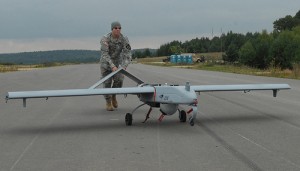
US Army.mil Flickr/CC License
How do we enable the US military to shift its thinking about defense and security, and accelerate civilian commercialization of technology systems that could reboot the US economy?
The US Military continues to evolve through its decades long transition from a Cold War military force to one that is better suited for the geopolitical realities of the 21st century. Last week President Obama, Defense Secretary Robert Gates and Senate leaders were successful in making the case for a symbolic phase transition of military spending by cutting out $1.7 billion for another round of F-22 jet fighters. Their vision is to move beyond the past Cold War era of weapon systems designed for big battle fields and superpower conflicts, towards systems designed for a more uncertain world that is more geopolitically fragmented. The key to changing how we invest in defense systems will, of course, rest on our ability to change mindsets of defense contractors and politicians focused on preserving jobs associated with the Cold War era model.
And, without ignoring the very serious issues of our ‘Military Industrial Complex’ [Video of Eisenhower’s Final Speech, Warning, 1961], how do we best harness this defense industry paradigm shift to improve civilian life and facilitate more positive economic and cultural globalization.
Obama and Gates might get us further along by injecting a new vision of military-civilian technology transfer systems that could enable a renaissance in US manufacturing and software-hardware systems design between 2010-2025:
- Autonomous Vehicle Systems (e.g. DARPA Grand Challenge, UAVs/Micro-‘Drones’)
- Sensor network-based Situation Awareness Systems
- Personal Assistant Software (e.g. CALO Project spin-off Siri Personal Assistant) including real-time language translation
- Functional Telepresence (e.g. tele-robotic surgery, haptic-based immersive control systems)
- Energy- Portable Power (e.g. micro-fuel cells), Bio-energy Production (e.g. algae) and Distributed Power Generation
- Distributed Information System Architecture
- Infrastructure Management / Supply Chain Management
- Exoskeleton Systems that augment human bio-mechanical movement (e.g. Aging populations; Factory workers)
These are a few of the powerful, forward-looking ideas that could give birth to new industries capable of replacing Cold War era job losses with 21st century civilian sectors. And they are all ripe for first stage commercialization during the next decade.
So which companies should we be watching?
First, it is important to note that I am much more interested in civilian applications of non-weapon systems, than trying to embrace or advocate for the development of next generation killing machines. I would prefer to see President Eisenhower’s speech played weekly in between acts on American Idol until our self-celebrity obsessed citizenry wakes up- and demands for greater transparency to Congress and Defense Contractors. Yes we should make sure that we present a balanced picture of the role defense plays in our budget spending and guiding our industrial base (good, bad and ugly!)
And I am not naive to believe that the beginning of this post-Cold War era military is a clean break from the old ways of our Congressional Military Industrial Complex. Large, powerful defense contractors will continue to lobby for, and receive, billions of dollars (e.g. F-35 Joint Strike Fighter) in weapon systems capable of causing death and destruction.
Yet I do believe that traditional defense companies are capable of developing non-weapon systems that bring tremendous value to the world beyond warfare. And that entrepreneurs can leverage the foresight and early stage investments of military funding resources to commercialize private sector products and services.
A few examples to note:
- Lockheed Martin is investing in Ocean Thermal Energy conversion and next generation information system architectures for government services
- Boeing is involved in research and development of algae-derived aviation fuels
- Raytheon is working develop an advanced wireless communication system MAINGATE, and advanced nanotechnology-based thermal materials used in electronic, and industrial waste recapturing systems based on carbon eating algae
- Honeywell and Rockwell Automation are working to evolve how we manage building energy systems and infrastructure
There are a number of smaller, more engineering oriented companies developing systems that could help reinvent major US industry sectors.
- Force Protection is developing light weight high strength materials that could be used in vehicles and product design
- iRobot and AeroVironment are advancing autonomous vehicle systems that could change how we look at transportation systems.
- Siri is a ‘soon to be launched’ Personal Assistant software program built upon early military research from the CALO Projec
What non-weapon applications do you believe could be leveraged in the private sector world between 2010-2025? (Comment below!)
Related posts:
